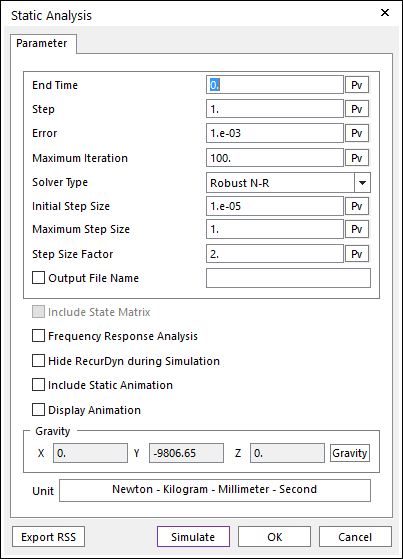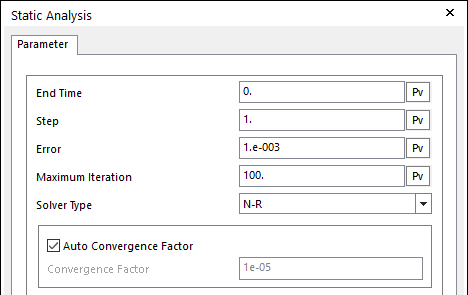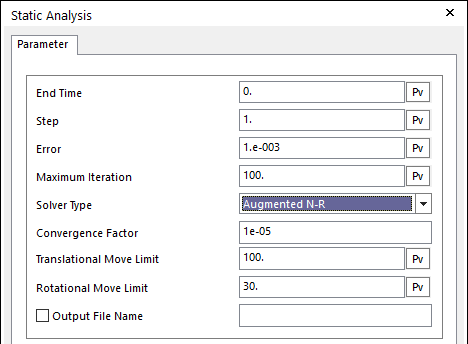

Figure 1 Static Analysis dialog box[Parameter]
•End Time: Defines the end time of simulation
•Step: Defines the number of sampling data sets for reporting and especially determines step size of simulation.
•For example, if End Time is 10 seconds and Step is 11, static analysis will be carried out ten times at intervals of 1 second for 10 seconds.
•Error: Defines the criterion of convergence.
•Maximum Iteration: Defines the number of maximum iterations of Newton method.
•Solver Type: Selects the solver type. RecurDyn supports three methods of N-R, Robust N-R and Augmented N-R for solving static problems.
•N-R: is using the Newton-Raphson iteration and it covers MBD, MFBD.

Figure 2 Static Analysis dialog box [N-R]
o Convergence Factor: If a system has a neutral equilibrium position, the Jacobian system for Newton's method is singular. This factor is added to the diagonal terms of the Jacobian matrix to prevent the singularity. A large factor is generally expected for stiff systems. If a system is failed to converge, a larger factor must be used.
o Auto Convergence Factor: If this option is checked, RecurDyn/Solver is used to find the Convergence Factor without user-defined setting.
•Robust N-R: is using Newton-Raphson iteration with a stabilizer that handles dynamic effect and it covers MBD, MFBD, Belt, Chain and Track.

Figure 3 Static Analysis
dialog box [Robust N-R]
o Initial Step Size: In Robust N-R, it defines the initial step size that can initially control the magnitude of variation of generalized coordinates to approach contact point. As the value of initial step size is small, it takes a long time for convergence. If you increase this value in stable range, you can get the equilibrium positions in the short time.
o Maximum Step Size: Defines the maximum step size of the integrator during the simulation.
o Step Size Factor: In Robust N-R, it defines the step size factor that is the variation of step size. As the value of step size factor is big, the step size can change largely.
•Augmented N-R: is using the line search to find optimal solution and it covers MBD, MFBD.

Figure 4 Static Analysis dialog box [Augmented N-R]
o Translational Move Limit: In Augmented N-R, it defines the limitation of the translational movement on the one step.
o Rotational Move Limit: In Augmented N-R, it defines the limitation of rotational movement on the one step.
o Note: It is recommended that FFlex model have a small value like 0.1~1.0.
•Output File Name
•If this option is checked, it allows defining the model output file name before simulation.
•If this option is not checked, the output file name will be the file name. (The default is unchecked.)
•Include State Matrix: If this option is checked, a state matrix is created prior to a dynamic analysis. For more information, refer to State Matrix.
•Direct Frequency Response Analysis: If this option is checked, a frequency response analysis is performed prior to a dynamic analysis. For more information, refer to Frequency Response Analysis.
•Hide RecurDyn during Simulation: Refer to Hide RecurDyn during Simulation in Dynamic/ Kinematic Analysis.
•Include Static Animation: Saves all animation of the iteration result created when you find the equilibrium position for initial state and each step. If this option unchecked, animation of equilibrium state for every step is shown only.
•Display Animation: If this option is checked, an animation is displayed during the simulation process.
•Unit: Shows using unit in the current model.
•Export RSS: Exports RSS file as current option.
Note
If the system includes a Belt, Chain, or Track subsystem, RecurDyn supports only Robust N-R.